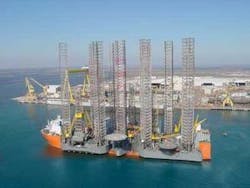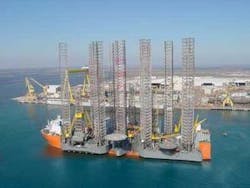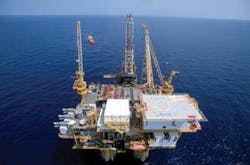GULF OF MEXICO
David Paganie, Houston
Rig migration continues
Four more rigs are leaving the Gulf of Mexico for higher day rates overseas, further widening the region’s supply deficit.
GlobalSantaFe contracted with Saudi Aramco to supply four jackup rigs for four-year terms offshore Saudi Arabia, with a day rate of approximately $160,500 (plus $24 million mobilization fee).
The four rigs:GSF Main Pass I, GSF Main Pass IV, GSF High Island I, and GSF High Island II; are scheduled to mobilize from the GoM in 4Q06 to a Middle East shipyard for 60 days of upgrades. The rigs then will move offshore to undertake the contracted drilling program beginning in March and April 2007.
According to GlobalSantaFe, “this is the largest drilling contract ever signed by the contractor, and is believed to be the largest jackup agreement in the history of the offshore drilling industry.”
On the bright side, as the jackup supply deficit continues to increase in the GoM, contractors with a strong presence in the region likely will benefit from improved day rates and contract durations.
Meanwhile, as of May 31, 2006, TODCO still has five of the 10 jackups based in the GoM listed as idle and available for work.
Deepwater discoveries
Noble Energy drilled a successful well on its Raton prospect in Mississippi Canyon block 248 in 3,400 ft of water.
The discovery well No. 1 was drilled to a total measured depth of 20,106 ft and encountered 90 ft of hydrocarbon pay over three zones, according to Noble. The well has been temporarily abandoned pending further delineation drilling, currently scheduled in 4Q06.
The operator plans to conduct appraisal work on its Redrock discovery, five mi to the north, as well, to help formulate a combined development plan for both fields.
These two discoveries are adjacent to two other blocks Noble and its partners obtained through OCS Lease Sale 198, held in March. The company now has eight contiguous leases across the area.
Noble Energy is the operator of Raton with a 50% working interest; Samson Offshore and Energy Partners each hold a 25% working interest.
Murphy Oil also hit pay with its Thunder Bird well on Mississippi Canyon block 819 in 5,673 ft of water. According to Murphy, it expects to develop the field through subsea tieback to a nearby host facility. However, the development plan has not been finalized.
Murphy is operator and 37.5% owner of Thunder Bird; Dominion E&P and Hydro GoM each hold a 25% working interest; and Marubeni holds the remaining 12.5% interest.
Louisiana Governor moves to block Lease Sale 200
Louisiana Governor Kathleen Blanco moved to block the MMS’s upcoming Lease Sale 200 over insufficient OCS revenue sharing with coastal states.
Blanco, in a letter to the MMS, declared the proposed western Gulf sale “inconsistent” with the state’s Coastal Zone Management Program.
“The failure of the federal government to take action to protect the coastal resources of Louisiana continues to endanger the lives of our people, the future of our economy, and the stability of our nation’s oil supply. I cannot and will not stand by idly while we continue to lose an entire football field of coastal wetlands every 38 minutes,” says Blanco.
Blanco also says she is prepared to take legal action to block the lease sale unless federal policy is enacted that would share OCS revenues with Louisiana so it can protect its coast. Otherwise, the government must take steps acceptable by the state to protect and restore the area.
“The state of Louisiana can no longer accept new OCS leasing or development activities off its coast without sufficient assurance from the federal government that it has adequately studied and considered the potential impact of such activities to the state’s coastal resources and communities in the post-Katrina and post-Rita environment,” she says.
“I am using legal powers afforded me to protect the coast of Louisiana and will challenge Lease Sale 200 and future OCS lease sales until the federal government makes such a commitment.”
The proposed lease sale includes around 3,787 unleased blocks covering approximately 20.4 million acres in the western GoM OCS planning area offshore Texas and in deeper waters offshore Louisiana.
The blocks are from nine to around 210 mi offshore in water depths of four to more than 3,425 m. The MMS estimates the proposed lease sale could result in the production of 136 to 262 MMbbl of oil and 0.81 to 1.44 tcf of natural gas.
Propose Lease Sale 200 is scheduled to be held in New Orleans on Aug. 16, 2006.
House unanimously approves OCS energy policy
Representatives of the House Committee on Resources, chaired by Richard Pombo (R-California), approved the bipartisan OCS energy policy - Deep Ocean Energy Resources (DOER) Act - by a vote of 29 to 9.
Coastal states also expressed their unwavering approval of the legislation in a letter to Pombo, signed by Governors Kathleen Blanco (Louisiana), Haley Barbour (Mississippi), Bob Riley (Alabama), and Rick Perry (Texas).
The plan represents a compromise between previous bills authored by committee members, John Peterson (R-Pennsylvania), Neil Abercrombie (D-Hawaii), Bobby Jindal (R-Louisiana), and Charlie Melancon (D-Louisiana).
The Pombo-lead policy grants the Secretary of the Interior the authority to renegotiate OCS leasing agreements finalized in 1998 and 1999, which omitted price thresholds that reportedly has avoided royalty payments to the federal government of around $10 billion.
According to the proposed Act, for those 1998 and 1999 lease-holders unwilling to renegotiate, a new Conservation of Resources fee will be levied upon each unit of production of oil & gas. It further mandates the inclusion of a price threshold in all future leases.
At print, the bill was scheduled to move to the House floor during the week of June 26 for a vote, before moving to the Senate.
Act highlights:
- Codifies the executive moratorium into permanent law, for the first time ever, banning oil & gas leasing within 50 mi of the coastline. This does not expire, but allows states to opt-out with the express approval of the state legislature and agreement of the governor.
- States are given one year from the date of enactment of the DOER Act to decide whether to permit or deny natural gas leasing in the area between 50 mi and 100 mi off their coastlines. If a state does not act, natural gas, but not oil, leasing can occur.
- For oil leasing, states have until June 30, 2009, to enact a prohibition on activities in the area between 50 mi and 100 mi from the coast.
- States are given the power to extend the prohibitions against either oil & gas leasing or natural gas leasing, in up to 5-year increments, by simple votes of the legislature on extending the prohibition against oil & gas and/or natural gas leasing.
- Prohibits all leasing within 25 mi off the coastline of a neighboring state that does not support leasing within its adjacent zone. It also prohibits issuing an oil & gas lease within 50 mi of the coastline of a neighboring state that does not support leasing.
- Repeals the OCS inventory provision of EPACT.
- Provides for a sharing of 75% of OCS revenues within the area between state waters and 12 mi offshore, and a sharing of 50% of OCS revenues with adjacent states and nearby producing states over time.
- Creates a new Federal Energy Natural Resources Enhancement Fund, Federal Energy and Mineral Resources Professional Development Fund, and the National Geo Fund.
Revenues from these funds will be spent for a number of purposes including education, transportation, reducing taxes, coastal, environmental and wildlife restoration, energy infrastructure and projects, state seismic monitoring programs, alternative energy development, energy efficiency and conservation, hurricane and natural disaster insurance programs, and others.
BHP sanctions Shenzi
BHP Billiton has approved the $4.4 billion development of the Shenzi field in Green Canyon blocks 609, 610, 653, and 654.
The field will be exploited with a standalone, Moses-designed TLP supplied by Modec International, capable of processing 100,000 b/d of oil and 50 MMcf/d of gas.
The host facility will be installed on Green Canyon block 653 in 4,300 ft of water.
First production from Shenzi is expected in mid-2009 through seven pre-drilled subsea wells. Full field development will include 15 production wells and water injection facilities.
BHP secured drilling agreements with GlobalSantaFe for use of theGSF C.R. Luigs and GSF Development Driller I, which is under contract with the operator through mid-2008.
Gross recoverable reserves from Shenzi are estimated at 350-400 MMboe. BHP operates Shenzi with a 44% working interest. BP and Hess each hold a 28% stake.
Closed loop LNG denied
Louisiana Governor Kathleen Blanco blocked construction of a proposed offshore liquefied natural gas port over concerns of potential long-term adverse economic and environmental impacts.
Blanco issued a letter of objection with the Maritime Administration (MARAD) to a Deepwater Port license application filed by McMoran Exploration for its Main Pass Energy Hub (MPEH) proposed offshore LNG project.
The Governor’s primary objection stemmed from the lack of “persuasive scientific studies or data” to support McMoran and other industry sources positions that environmental impacts of using open rack vaporization (ORV) technology at the MPEH would be negligible.
“I will oppose the licensing of offshore LNG terminals that will use the ORV system. Until studies demonstrate that the operation of the ORV will not have an unacceptable impact on the surrounding ecosystem, I will only support offshore LNG terminals using a closed loop system having negligible impacts to marine life,” says Blanco.
A closed loop regasification system uses natural gas rather than seawater to warm the LNG.
“Requiring the use of more costly closed loop systems, which would consume an incremental 3.5 Bcf per annum for MPEH alone, will only exacerbate the growing energy crisis in the US,” says McMoran Co-Chairmen, James Moffet and Richard Adkerson, in response to the application denial.
As a result, McMoRan filed an amended license application with the US Coast Guard and the MARAD on May 31, 2006, to obtain approval for the LNG project using closed loop technology. MARAD will establish a new timeline for the project, including the publication of a supplemental Environmental Impact Statement and a final public hearing followed by a record of decision.
The proposed terminal would be capable of regasifying LNG at a rate of 1 bcf/d. The facility will be situated in around 210 ft of water. McMoran says it is continuing discussions with potential LNG suppliers, gas marketers, and consumers in the US to develop commercial arrangements for the facilities.


